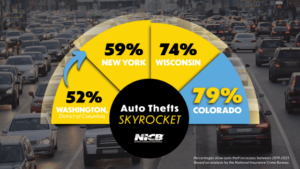INTRODUCTION
Carjacking and auto theft represent serious crimes that involve the theft or unauthorized use of motor vehicles, posing risks to public safety, property owners, and communities. These criminal activities are often driven by opportunistic criminals seeking financial gain, transportation, or involvement in other illicit activities. In this comprehensive analysis, we’ll delve into the intricacies of carjacking and auto theft, examining their characteristics, societal impacts, law enforcement challenges, and strategies for prevention and deterrence.

1. Carjacking: Carjacking is a violent form of auto theft that involves the theft of a motor vehicle through force, intimidation, or threat of violence against the driver or occupants. Carjackers may ambush victims at gunpoint, use physical force, or employ deceptive tactics to gain control of the vehicle.
2. Characteristics of Carjacking:
- Carjacking incidents often occur in urban areas, parking lots, intersections, or residential neighborhoods where vehicles are stationary or slowing down, making them vulnerable targets for theft.
- Carjackers may target specific types of vehicles, such as luxury cars, SUVs, or trucks, based on their perceived value, desirability, or suitability for resale or use in other criminal activities.
- Carjacking perpetrators may act alone or in groups, sometimes collaborating with organized crime networks or street gangs to steal vehicles for profit, transportation, or commission of other crimes.
3. Impacts of Carjacking:
- Carjacking victims may suffer physical injuries, trauma, and emotional distress as a result of violent confrontations, assaults, or threats during the theft of their vehicles.
- Carjacking incidents can have long-term psychological effects on victims, leading to feelings of vulnerability, fear, and insecurity, especially if they are targeted repeatedly or subjected to extreme violence.
- Carjacking poses risks to public safety and law enforcement, as stolen vehicles may be used in other crimes, such as armed robberies, drug trafficking, human smuggling, or terrorist activities.
4. Auto Theft: Auto theft involves the unauthorized taking, possession, or use of motor vehicles without the owner’s consent, either for joyriding, resale, stripping for parts, or other illegal purposes. Auto thieves may employ various methods to steal vehicles, including hotwiring, lock-picking, key theft, or exploiting vulnerabilities in vehicle security systems.
5. Characteristics of Auto Theft:
- Auto theft is often opportunistic, with thieves targeting vehicles left unattended, unlocked, or with keys left inside, making them easy targets for theft.
- High-value or luxury vehicles may be targeted for theft due to their resale value, parts availability, or demand in black markets for stolen goods.
- Auto theft rings may operate across multiple jurisdictions, utilizing sophisticated techniques, such as identity theft, VIN cloning, or electronic hacking, to steal, conceal, and dispose of stolen vehicles.
6. Impacts of Auto Theft:
- Auto theft imposes significant financial losses on vehicle owners, insurers, and society as a whole, resulting in increased insurance premiums, vehicle replacement costs, and law enforcement expenditures.
- Stolen vehicles may be used in other criminal activities, such as drug trafficking, smuggling, illegal immigration, or transportation of stolen goods, exacerbating public safety risks and law enforcement challenges.
- Auto theft contributes to the proliferation of black markets for stolen vehicles and parts, fueling organized crime, corruption, and violence in communities affected by auto theft-related activities.

7. Law Enforcement Challenges:
- Combatting carjacking and auto theft poses challenges for law enforcement agencies, including resource constraints, jurisdictional complexities, and the evolving tactics of criminals.
- Investigation and prosecution of carjacking and auto theft cases require specialized training, forensic expertise, and collaboration between local, state, and federal law enforcement agencies.
- Prevention efforts must address the root causes of carjacking and auto theft, including poverty, unemployment, substance abuse, and lack of access to legal employment opportunities for at-risk individuals.
8. Prevention and Deterrence Strategies:
- Implementing comprehensive crime prevention strategies, such as community policing, neighborhood watch programs, and public awareness campaigns, can deter carjacking and auto theft by increasing visibility, vigilance, and community engagement.
- Enhancing vehicle security features, such as alarms, immobilizers, tracking devices, and steering wheel locks, can make it harder for thieves to steal vehicles and reduce the risk of theft.
- Strengthening penalties for carjacking and auto theft, including mandatory minimum sentences, forfeiture of assets, and restitution to victims, can deter offenders and hold them accountable for their actions.

In conclusion, carjacking and auto theft are serious crimes that pose significant risks to public safety, property owners, and communities. Addressing these challenges requires coordinated efforts from law enforcement agencies, policymakers, community stakeholders, and the private sector to prevent theft, apprehend offenders, and mitigate the impacts of these criminal activities. By implementing effective prevention and deterrence strategies, enhancing vehicle security measures, and promoting public awareness, stakeholders can reduce the prevalence of carjacking and auto theft and create safer environments for all residents.



